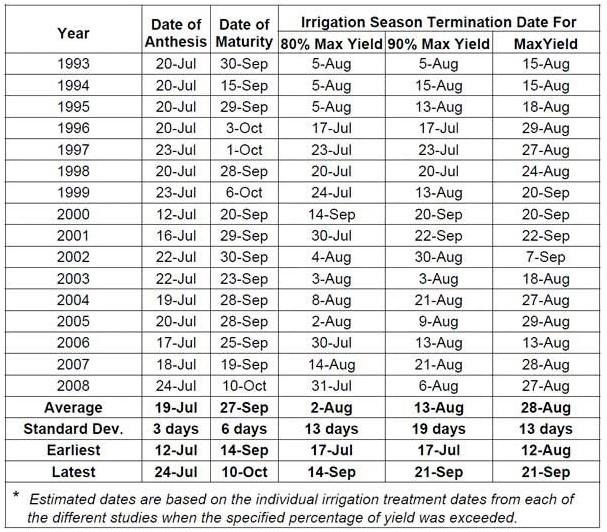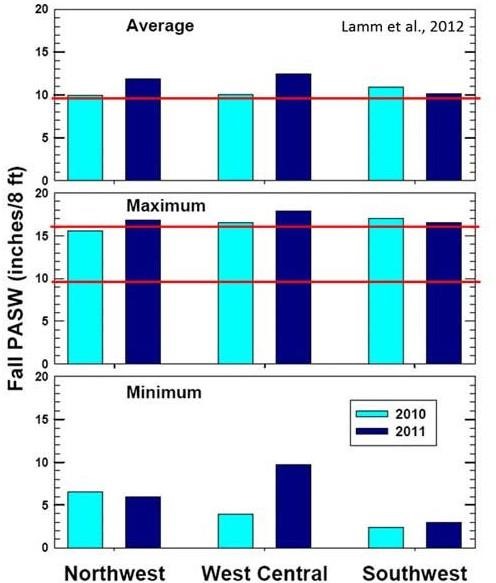By Lucas Haag
This year has been especially challenging for irrigators as we started the year with below normal levels of profile water in most places followed by below normal precipitation. As we look towards the end of the irrigation season, producers have an opportunity to improve their water productivity by properly timing their final irrigation application. This is an important decision as an early termination of irrigation can result in reductions in grain yield, primarily through reductions in the kernel weight yield component. Conversely, a late termination of irrigation results in unnecessary pumping, energy consumption, and increasing the risk of soil compaction at harvest due to increased soil water and the risk of water loss through drainage.
With the goal of matching available water to crop needs while avoiding excess, it is important to understand crop water use requirements late in the growing season. Anticipated water use from various growth stages until physiological maturity for corn, grain sorghum, and soybeans is shown in Table 1.
Table 1. Anticipated water use for corn, grain sorghum, and soybeans at various growth stages.
Stage of Growth | Approximate number of days to maturity | Water use to maturity (inches) |
Corn | | |
| Blister | 45 | 10.5 |
| Dough | 34 | 7.5 |
| Beginning dent | 24 | 5 |
| Full dent | 13 | 2.5 |
| Black layer | 0 | 0 |
| | | |
Grain Sorghum | | |
| Mid bloom | 34 | 9 |
| Soft dough | 23 | 5 |
| Hard dough | 12 | 2 |
| Black layer | 0 | 0 |
| | | |
Soybeans | | |
| Full pod | 37 | 9 |
| Beginning seed | 29 | 6.5 |
| Full seed | 17 | 3.5 |
| Full maturity | 0 | 0 |
Adapted from K-State MF2174, Rogers and Sothers. |
Research in western Kansas has shown the importance of keeping the management allowable depletion limited to 45% during the post-tassel period. In other words, maintaining available soil water contents above 55%. By knowing anticipated water use from a given growth stage and the remaining soil water in the profile, producers can add just enough irrigation water to meet that demand and maintain profile available soil water content above 55%.
By closely following the growth and development of the crop, one can know when physiological maturity, i.e. black layer in corn, has been reached and at that point water use for the production of grain yield has ceased and additional irrigation is certainly unnecessary.
Termination based on calendar dates
Traditionally many producers have used a fixed calendar date to determine their final irrigation. Long-term studies conducted by Freddie Lamm at the Northwest Research-Extension Center at Colby show the potential problems in this approach. Table 2 shows silking, maturity, and irrigation termination dates for a long-term study in corn. Over the course of this study, the irrigation termination date for maximum grain yield varied from August 12 to September 21. This is a significant departure from a general rule of thumb using Labor Day as a termination date. As shown, the use of a fixed date on the calendar without regard to crop progress, soil water status, or ET demand would have resulted in both forfeited yield and wasteful pumping across this timeframe.
Table 2. Silking, maturity, and irrigation termination dates for a long-term study in corn.

Consequences of excess late-season irrigation
In the silt-loam soil profiles common in western Kansas, water drainage out of the soil profile starts to occur when the profile water content rises above 60% available soil water. The rate of drainage loss increases rapidly with increasing water content. Late-season irrigation in excess of crop water use results in increased accumulation of water in the profile, which is subject to drainage losses. A survey of irrigated corn fields was conducted in 2010 and 2011 (Figure 1). Fields were surveyed after corn harvest across three east-west transects in western Kansas.

Figure 1. Results from 2-year survey of irrigated corn fields. Fields were surveyed after harvest across three east-west transects in western KS.
The line at 9.6 inches of plant-available soil water (PASW) denotes the approximate water content where drainage losses would start to occur. On average, most producer fields were near this level of soil water storage indicating a good management strategy as drainage losses had been minimized while yet maintaining adequate soil water to complete grain fill.
Producer fields near the minimum observed values likely did not have adequate soil water to ensure maximum grain yields. The most concerning scenario however, are the fields at the upper end of soil water values such as the maximum observation. The red line at 16 inches PASW represents field capacity, the point at which free drainage and significant water losses from the profile would occur. In the wettest producer fields, in all three regions, significant amounts of free drainage and water loss would have been occurring at the time of crop maturation and harvest.
Timing of the final irrigation:
- Determine crop growth stage and anticipated remaining water use
- Determine soil water status in the field by probe or calibrated soil sensor technology
- Determine irrigation strategy necessary to meet remaining crop water use while maintaining soil water content at or above 55% (limit depletion to 45%).
- Be ready to make adjustments based on changes in ET demand, precipitation, etc.
Source : ksu.edu